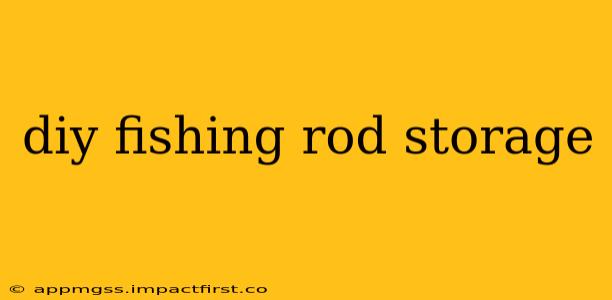Are you tired of tangled fishing rods cluttering your garage or taking up precious space in your car? Effective fishing rod storage is crucial for maintaining your equipment and ensuring you're ready for your next fishing adventure. Fortunately, creating a DIY fishing rod storage solution doesn't have to be complicated or expensive. This guide explores several creative and practical options to keep your rods organized, protected, and easily accessible.
What are the best ways to store fishing rods?
This is a common question among anglers. The best way to store fishing rods depends largely on your available space, the number of rods you own, and your budget. Some anglers prefer simple, inexpensive solutions, while others invest in more elaborate systems for maximum protection and organization. We’ll cover several DIY options to cater to various needs and preferences.
How do I build a DIY fishing rod rack?
Building a DIY fishing rod rack is a surprisingly straightforward project, even for beginners. Here’s a breakdown of a simple yet effective design:
Materials:
- Wooden dowels (diameter depends on rod handle size)
- Wooden board (for the base)
- Screws
- Drill
- Saw (to cut dowels to length)
- Sandpaper (for smoothing)
- Wood stain or paint (optional)
Instructions:
- Measure the length of your longest fishing rod. This will determine the length of your dowels.
- Cut the dowels to the desired length.
- Drill pilot holes into the wooden board, spacing them according to the number of rods you want to store.
- Securely attach the dowels to the board using screws.
- Sand down any rough edges.
- Apply wood stain or paint for a polished finish (optional).
This simple rack can be mounted on a wall, inside a closet, or even on the back of a door. You can customize the size and design to fit your specific needs.
How can I store fishing rods in a small space?
Limited space doesn't mean you have to compromise on proper fishing rod storage. Consider these space-saving DIY options:
- PVC Pipe Storage: Use lengths of PVC pipe, secured to a wall or inside a closet, to hold your rods. The pipes protect the rods and are incredibly compact.
- Repurposed Ladder Rack: An old ladder can be transformed into a charming and functional fishing rod rack. Simply secure it to a wall and use the rungs to hold your rods.
- Under-the-Bed Storage: Utilize the often-unused space under your bed. Build a simple platform with dowels to hold your rods horizontally, keeping them protected from dust and damage.
What is the cheapest way to store fishing rods?
One of the cheapest ways to store fishing rods is by using simple hooks or clips attached to a wall or ceiling. This method works best for a small number of rods. You can use inexpensive hooks from a hardware store and attach them directly to a sturdy wall or beam. This approach requires minimal materials and effort, making it ideal for those on a tight budget.
How do you store fishing rods vertically?
Vertical storage is a great space-saving option. The DIY wooden dowel rack described above can be easily adapted for vertical storage. Simply increase the length of the dowels to accommodate the full length of your rods. Alternatively, you could utilize a section of pegboard, drilling holes to accommodate the rod butts. This allows for easy access and prevents rods from scratching each other.
How to protect fishing rods during storage?
Proper protection during storage is key to prolonging the lifespan of your valuable fishing rods. Consider these tips:
- Rod Sleeves: Use protective sleeves or cases for individual rods to prevent scratches and damage.
- Clean Rods Before Storing: Clean your rods after each use to remove any dirt, salt, or grime that could potentially damage the finish.
- Store in a Dry Place: Avoid storing your rods in damp or humid environments to prevent mold and mildew.
By following these DIY methods and protective measures, you can create a custom fishing rod storage solution that is both efficient and budget-friendly. No more tangled lines or damaged rods! Choose the method that best fits your space, budget, and personal preferences. Happy fishing!
